INTRODUCTION
Plants possess medicinal properties due to the presence of diverse bioactive compounds. Since antiquity, several reports have been published on medicinal plants in drug discovery [1]. Medicinal plants are considered as primary health care system for the rural population in many countries till now [2]. Utilizing plants for medication is less detrimental and also less expensive [1]. To reduce human suffering, herbs have played an important role in traditional and also in the new generation [3]. Primeval ethno pharmacology has been contemplated as a major tool in the new drug discovery. Herbal medicines are a favored form of complementary and substitute medicine practiced worldwide to treat various types of disorders [4]. Indigenous use of botanicals takes part in a crucial role in human and livestock wellness in a wider part of the world notably in impoverished and developing countries [3]. Crude herbal compositions with or without additives are described to have an outstanding therapeutic value [3]. As reported by Sofowora [5] about 60%–85% of the inhabitants in the countries of the developing world have to depend on traditional medicine [5]. The application of traditional medicine is extensive in India, Korea, Japan, Sri Lanka, Thailand, Pakistan, and China [6,4].
India is rich in medicinal plants. From the ancient period plants were used to cure various diseases in different districts in India [7]. Ethnomedicinal plants are also used widely in Ayurvedic treatment [8].
Almost 25% of modern medicines are obtained from nature, some of which were extracted from traditional uses [9]. Humans depend greatly on plants and their products for food, shed, clothing, and also for their benefaction to support the ecosystem [10]. The tribal people live in or near the forest area so they collect the plants easily and make use of them for treatment of diseases caused by some infectious pathogens [11]. The healers of particular tribal regions use different parts of plants and make a paste with the help of different natural ingredients and apply them on the patients’ wounded areas or instruct them to take the medicines orally for a certain period [12].
The tribal people of the Purulia district follow the traditional ethnomedicinal practices for the treatment of many diseases. The medicine men collect the necessary plant materials from the forest according to the diseases and make medicine from them and give them to the sick persons [2]. The documentation of traditional knowledge of ethnobotanicals in the study area provides a scientific database for the validation and preservation of traditional knowledge [13]. It also opens up opportunities for future research and development of new plant-based medicines [3]. The conservation and sustainable use of ethnobotanicals can contribute to the socio-economic development of local communities as well as ensure the availability of these plants for future generations [13]. This study will contribute to the documentation of traditional knowledge on medicinal plants in the Purulia district of West Bengal, India.
MATERIALS AND METHODS
Study area
Purulia is situated in the westward of West Bengal in India (Figure 2). It has a latitude and longitude of 22ºC6′ to 23ºC5′ N and 85ºC7′ to 86ºC6′ E, respectively. Geographically, Purulia covers 6,259 km2 area [13]. In summer the average temperature of this area is 40ºC and in winter the average temperature is 10ºC [2]. Here, the rainfall ranges between 1,100 and 1,500 mm yearly [13]. The flora of the district is comprised of several species of medicinal plants. The vegetation in the district ranges from tropical deciduous forests to dry scrublands and grasslands. The forest part shows several species of trees including sal, teak, bamboo, and mahua [13].
Ethnobiological data collection and analysis
The field study was conducted in 10 sessions from July 2021 to February 2022 based on ethnobiological investigations. Around five to six traditional healers participated in each session. A total number of 55 traditional healers participated in this study. Key informants belonging to various age groups were selected based on age, ethnicity, knowledge about ethnobotanical drugs, minimum 5 years of experience in healing, and recommendations obtained from local leaders of the villages. Informants were assured by me that data obtained from this study would be used only for research purposes. All informants were more than 18 years of age and participated voluntarily. Informants were also found intense knowledge about habit type, flowering time, method of preparation, and side effects of ethnobotanicals. A sheet of semi-structured questionnaire was prepared to collect data systematically along with a short profile of informants.
As the authors know the native language of healers so semistructured questionnaire were prepared in Bengali for the data collection based on the standard ethnobotanical method [13,14]. In this study, health problems were characterized into eight major groups such as dermatological problems, general health problems, abdominal problems, ear, nose, throat problems, nephrological problems, hormonal problems, orthopedic problems, and nervous problems. Medicinal plants mentioned by at least four informants were taken into consideration. Several plant species were collected mostly in their flowering stage for their identification but rare and protected species were avoided during the field study. These protected species were photographed only whenever possible. Some plant specimens were collected to make a herbarium and identified by herbarium specimens of the Botanical Survey of India, and rare and protected species were identified with the help of books and other authentic documents [15–18] Nomenclatures were verified using the database available in the online at www.ipni.org. The ethnomedicinal plants mentioned in this study were arranged alphabetically. Local names of plants, scientific names, family, therapeutic use, parts of the plants that are used, method of preparation, and mode of administration were stated in the present study. Collected information was evaluated using specific quantitative parameters viz. fidelity level (FL) and use value (UV) [19].
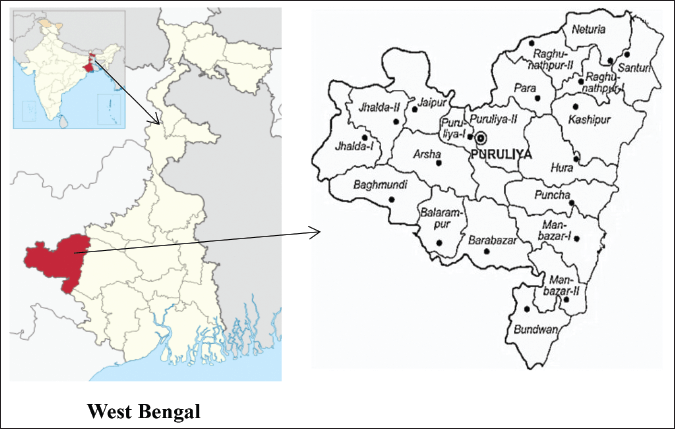 | Figure 1. Map of study area, “Purulia.” [Click here to view] |
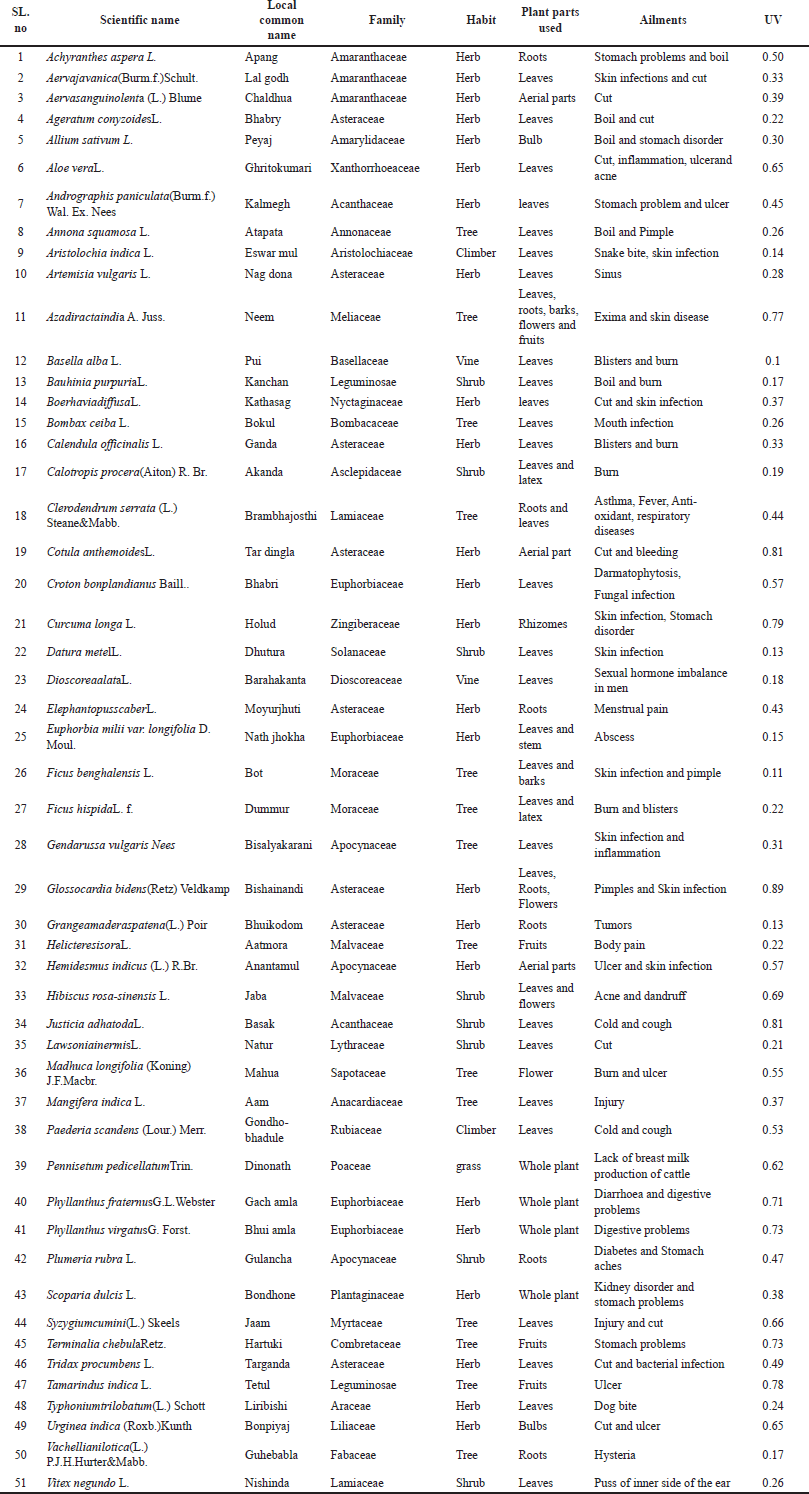 | Table 1. Ethnobotanical used for some diseases treatment. [Click here to view] |
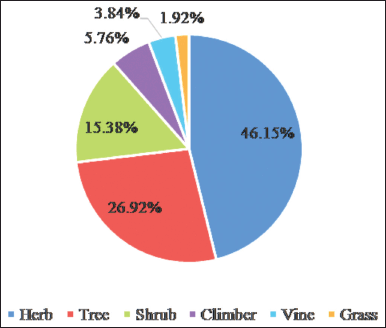 | Figure 2. Percentage of habit types of the studied plants used for the treatment of some diseases. [Click here to view] |
Use value
The UV validates the comparative importance of plants recognized locally in folk medicine [20]. UV was calculated using the following formula: UV = ∑U/n
where UV represents the UV of species, U represents the total number of respondents who reported the use of particular species, and n represents the total number of informants interviewed for a specific plant. High UV indicates the particular plant is medicinally important and it has several uses [21].
Fidelity level
The percentage of informants affirming the use of a specific plant species for a similar major perseverance was calculated through FL [22].
The formula is as follows: FL (%) = NP/N × 100
Here, FL is FL, NP describes the number of informants who independently mentioned the use of a species for the same diseases, and N describes the total number of informants who indicated the plant for any specific ailment [21].
RESULTS
Medicinal plant diversity and distribution
Medicinal plants were enlisted with scientific names and author citations, followed by local names, families, habits, and plant parts used against each disease (Table 1). Fifty-one plant species were identified and documented in this study which belonged under 51 genera and 34 plant families (Table 1). The highest number of medicinal plants were recorded in Asteraceae (7 species) followed by Amaranthaceae (3 species), Euphorbiaceae (3 species), and Malvaceae (2 species). It was found that the same plant species have a same local name in various parts of the study area among the different ethnic communities. This gives a strong homogeneity of vernacular nomenclature among inhabitants in the Purulia district, which is an indication of the transfer of indigenous knowledge. Medicinal plants were unevenly distributed to different blocks of the district but most of the species were available to Ajodhya Hill, Pancheyet Hill, Rakab Forest, Murguma Forest area, Bandwan Forest area, and Tara Forest.
Ethnomedicinal use of plants stated by the selected informants and documentation of their usage
The distribution of plant habit types and plant part (s) used are illustrated in Figures 2 and 3, respectively. Among the various habit types, 46.15% were herbaceous plants, 26.92% trees, 15.38% shrubs, 5.76% climbers, 3.84% vines, and 1.92% grasses were used for the treatment of diseases (Fig. 2). Among the parts used, leaves were the most preferable plant parts (52%), followed by roots (13%), flowers, whole plants, fruits, aerial parts, bark, latex, and bulbs as shown in Figure 3.
The majority of the identified medicinal plants were used for the treatment of dermatological problems (59.61%), general health problems (38.46%), and abdominal problems (28%) (Fig. 4). Quantitative ethno botanical study found high UV for Glossocardia bidens (Retz) Veldkamp (0.89), Justicia adhatoda L. (0.81), Cotula anthemoides L.(0.81), Curcuma longa L. (0.79), Azadiractaindia A. Juss. (0.77), Phyllanthus virgatus G. Forst. (0.73), and Phyllanthus fraternus G.L.Webster (0.71) (Table 1). The majority of the preparations in the study area were made from dried parts of ethnobotanicals followed by fresh parts. Traditional healers employ different methods of formulations of conventional medicine for the treatment of various ailments. A total number of 20 mono-herbal formulations (MFs) and 13 poly-herbal formulations (PFs) were reported as shown in Table 2.
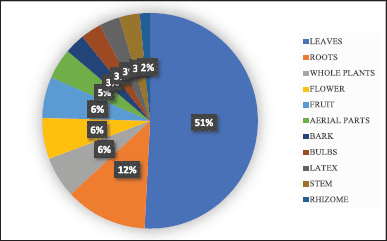 | Figure 3. Percentage of plant parts utilized for the medication. [Click here to view] |
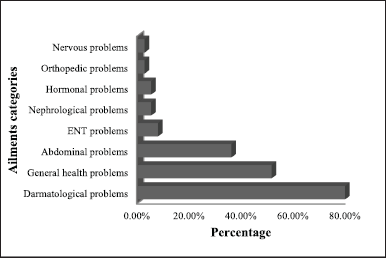 | Figure 4. Percentage of plant specimens used for medication of a particular health problem. [Click here to view] |
FL of the described plants
High FL was recorded for three plants viz. Azadiractaindia A. Juss. (89%), G. bidens(Retz) Veldkamp (81.04%), and Pennisetum pedicellatum Trin. (80.33%) as shown in Table 3.
DISCUSSION AND CONCLUSION
We report a total of 51 ethnobotanicals belonging to 34 plant families which are used directly or with some additives for the treatment of 8 different health problems in Purulia district. A high number of species reported designates that the district has a wide diversity of flora used against various ailments and rich indigenous traditional knowledge. Families Asteraceae, Apocyanaceae, and Amaranthaceae are widely documented in herbal formulations in parts of the district [2,13]. Asteraceae is reported to have a wide range of bioactive constituents thus contributing to the high UV of members of the family for medicinal purposes [13]. The UV of G. bidens (Retz) Veldkamp under Asteraceae is high as the different parts of it provide the necessary properties to cure diseases [2]. Dried parts of ethnobotanical plants are used widely as they are easy to preserve for a long time even when the season is not favorable for the particular plants to grow. Some healthy fresh parts of the plants are also used in some cases of disease treatment. This study corroborates the findings of Modak et al. [13]. In the present study, healers preferring to use leaves in comparison to other plant parts. The use of leaves for medicinal purposes is preferred by most ethnobotanical studies because they are available in most seasons and they are quickly reachable in the time of urgent situations [2,13]. The tribal people usually face dermatological problems possibly because of poor skin hygiene, environment, and weak immune system [9]. So, dermatological conditions are mostly treated. In most cases, the drug formulation is made from PFs because the mutual effect of the phytochemicals of different plants may recover the rate of curing [23–25]. Ethnobotanicals with high FLs are considered potential plants for further biochemical investigation and are worthy of priority interest [26,27]. The popularity of herbs as a source of herbal therapy is often attributed to their higher pharmacologically active constituents than trees [27]. Shrubs are preferred due to their availability throughout the year as they are relatively drought-resistant and unaffected by seasonal changes [28]. The lifesaving herbs and trees are decreasing day by day due to a lack of awareness among the public about the conservation of threatened species which can be achieved by educating them about the importance of conservation [28,29]. But with the help of local tribal medicine men, the primary health care system through ethnomedicine is still preserved. This present manuscript is an initial step to introduce folk medicine in digital format for future use and also preserve them from extinction.
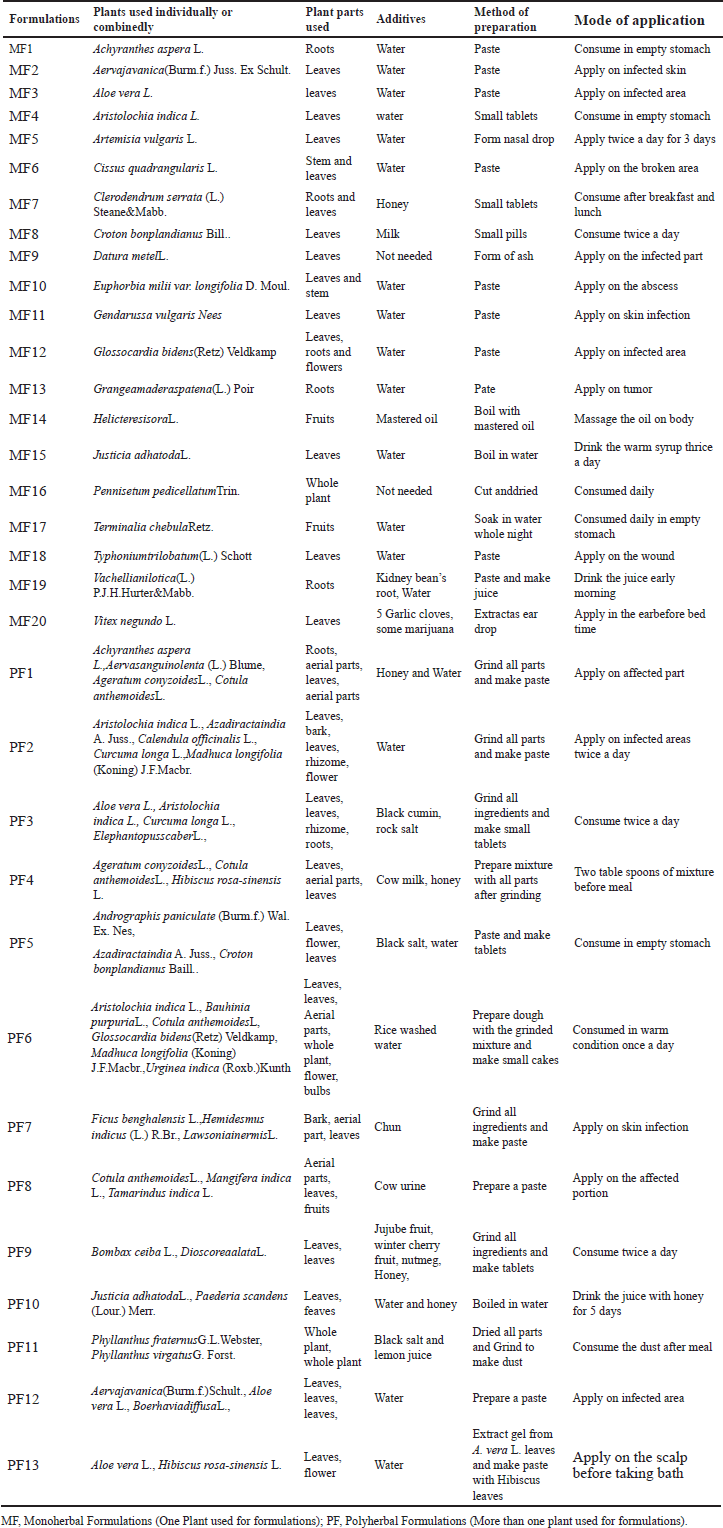 | Table 2. Specific details of formulations for treatment. [Click here to view] |
In conclusion, the documentation of traditional medicinal knowledge on ethnobotanicals in the study area could contribute to safeguarding the traditional knowledge, which is still transferred verbally among the local people. Furthermore, the information obtained from this investigation will provide a basis for biochemical studies that could further be used to develop new drugs.
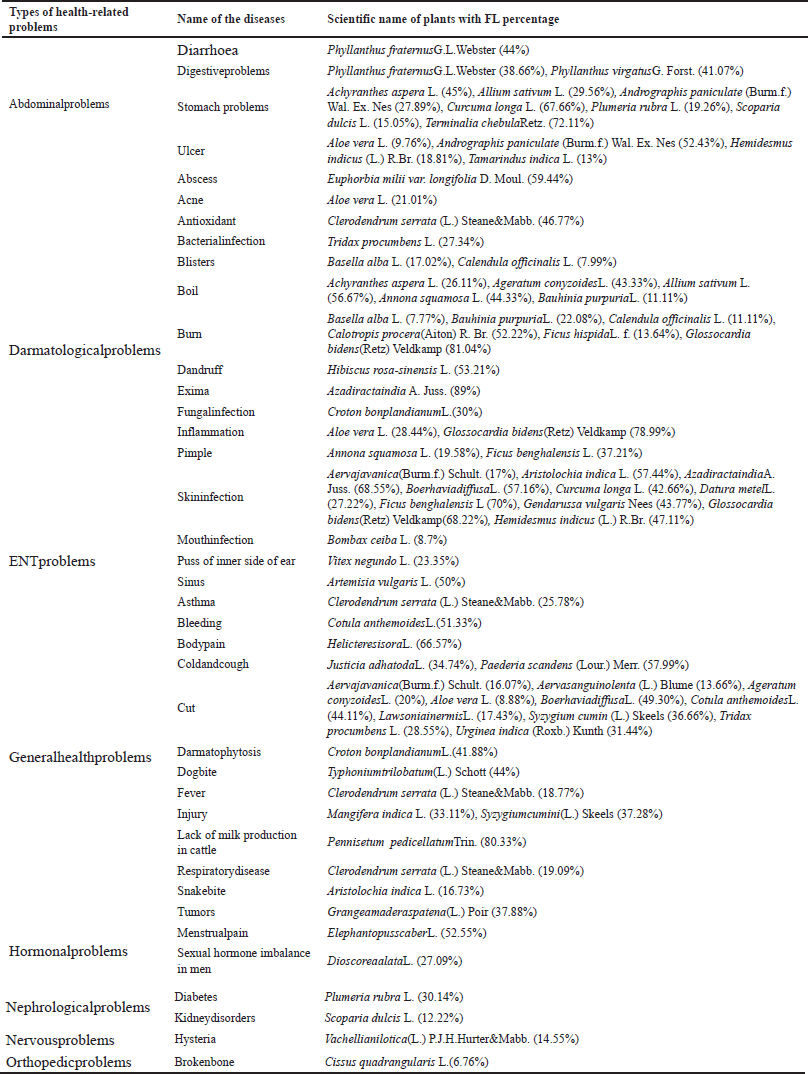 | Table 3. FL of described plants. [Click here to view] |
ACKNOWLEDGMENT
The first author is thankful to The Centre for Life Sciences and the Department of Botany and Forestry of Vidyasagar University for supporting this field study. The authors are grateful to the tribal people of the Purulia district who supported lot in completing the survey and also assisted in the documentation. Their guidance helped very much to introduce their traditional knowledge of medication worldwide through this publication.
LIST OF ABBREVIATIONS
FL, Fidelity level; MF, Monoherbal formulation; PF, Polyherbal formulation; UV, Use value.
AUTHOR CONTRIBUTIONS
All authors made substantial contributions to conception and design, acquisition of data, or analysis and interpretation of data; took part in drafting the article or revising it critically for important intellectual content; agreed to submit to the current journal; gave final approval of the version to be published; and agree to be accountable for all aspects of the work. All the authors are eligible to be an author as per the International Committee of Medical Journal Editors (ICMJE) requirements/guidelines.
FINANCIAL SUPPORT
There is no funding to report.
CONFLICTS OF INTEREST
The authors report no financial or any other conflicts of interest in this work.
ETHICAL APPROVALS
This study does not involve experiments on animals or human subjects.
DATA AVAILABILITY
All data generated and analyzed are included in this research article.
PUBLISHER’S NOTE
This journal remains neutral with regard to jurisdictional claims in published institutional affiliation.
REFERENCES
1. Laldingliani TBC, Thangjam NM, Zomuanawma R, Bawitlung L, Pal A, Kumar A. Ethnomedicinal study of medicinal plants used by Mizo tribes in Champhai district of Mizoram, India. J Ethnobiol Ethnomed. 2022;18:22. CrossRef
2. Mahato G, Hansda B, Banerjee N. Ethnobotanicals used for the treatment of skin diseases with special emphasis on carbuncle disease from Purulia district of West Bengal in India. Pharmacogn J. 2019;11(4):745–53. CrossRef
3. Dey A, De JN. Ethnobotanical survey of Purulia district, West Bengal, India for medicinal plants used against gastrointestinal disorders. J Ethnopharmacol. 2012;143(1):68–80. CrossRef
4. Park HL, Lee HS, Shin BC, Liu JP, Shang Q, Yamashita H, et al. Traditional medicine in China, Korea, and Japan: a brief introduction and comparison. eCAM. 2012;2012:5 CrossRef
5. Sofowora A. Medicinal plants and traditional medicine in Africa. New York, NY: John Wiley & Sons; 1982.
6. Jima TT, Megersa M. Ethnobotanical study of medicinal plants used to treat human diseases in Berbere district, Bale Zone of Oromia Regional State, South East Ethiopia. eCAM. 2018;2018 :5. CrossRef
7. Saikia AP, Ryakala VK, Sharma P, Goswami P, Bora U. Ethnobotany of medicinal plants used by Assamese people for various skin ailments and cosmetics. J Ethnopharmacol. 2006;106(2):149–57. doi: https://doi.org/10.1016/j.jep.2005.11.033 CrossRef
8. Adetutu A, Witson AM, Cororan O. Ethnopharmacological survey and in vitro evaluation of wound healing plants used in South-western Nigeria. J Ethnopharmacol. 2011;137(1):50–6. CrossRef
9. Lee C, Kim SY, Eum S, Paik JH, Bach TT, Darshetkar AM, et al. Ethnobotanical study on medicinal plants used by local Van Kieu ethnic people of Bac Huong Hoa Nature Reserve, Vietnam. J Ethnopharmacol. 2019;231:283–94. CrossRef
10. Abbiw DK. Useful plants in Ghana. London, UK: Richmond Intermediate Technology and Royal Botanic Gardens Kew; 1990. CrossRef
11. Appiah KS, Oppong CP, Mardani HK, Omari RA, Kpabitey S, Amoatey CA, et al. Medicinal plants used in the Ejisu-Juaben Municipality, Southern Ghana: an ethnobotanical study. Medicines (Basel). 2018;6(1):1. CrossRef
12. Hassan RBA. Medicinal plants (Importance and uses). Pharm Anal Acta. 2012;3:10.
13. Modak BK, Gorai P, Dhan R, Mukherjee A, Dey A. Tradition in treating taboo: folkloric medicinal wisdom of the aboriginals of Purulia district, West Bengal, India against sexual gynaecological and related disorders. J Ethnopharmacol. 2015;169:370–86. CrossRef
14. Paksoy MY, Selvi S, Savran A. Ethnopharmacological survey of medicinal plants in Ulukisla. J Herb Med. 2016;6:1–7. CrossRef
15. Bentham G, Hooker JD. Genera planterum. London, UK: Lovell Reeve and Co., 1862–83; 1–3 pp.
16. Pal DC, Jain SK. Tribal medicine. Kolkata, India: Naya Prakash; 1998.
17. Paria ND, Chattopadhyay SP. Flora of Hazaribagh district, Bihar, India. Bot Survey of India; 2002. vol. 2, 1299 p.
18. Prain D. Bengal plants. Dehra Dun, India: Bishen Singh, Mahendra Pal Singh; 1903. 1–2 pp.
19. Mrabti HN, Bouyahya A, Mrabti, Jaradat N, Doudach L, Faouzi MEA. Ethnobotanical survey of medicinal plants used by traditional healers to treat diabetes in the Taza region of Morocco. eCAM. 2021;2021:7. CrossRef
20. Vijaykumar S, Morvin Yabesh JE, Prabhu S, Manikandan R, Muralidharan B. Quantitative ethnomedicinal study of plants used in the Neliyampathy Hills of Kerala, India. J Ethnopharmacol. 2015;161:238–54. CrossRef
21. Phillips O, Gentry AH, Reynel C, Wilkin P, Galvez-Durand BC. Quantitative ethno botany and Amazonian conservation. Conserv Bio. 1994;8(1):225–48. CrossRef
22. Kadir MF, Karmokar JR, Alam MR, Jahan SR, Mahbub S, Mia MMK. Ethnopharmacological survey of medicinal plants used by traditional healers and indigenous people in Chittagong Hills tracts, Bangaladesh, for the treatment of snakebite. eCAM. 2015;2015:7. CrossRef
23. Gertsch J. Botanical drugs, synergy and network pharmacology: forth and back to intelligent mixtures. Planta Med. 2011;77(11):1086–98. CrossRef
24. Hamilton AC. Medicinal plants, conservation and livelihoods. Biodivers Conserv. 2004;13:1477–517. CrossRef
25. Kamatenesi-Mugisha M, Oryem-Origa H. Medicinal plants used toinduce labour during child birth in Western Uganda. J Ethnopharmacol. 2007;109:1–9. CrossRef
26. Ssegawa P, Kasenene JM. Medicinal plant diversity and uses in Sangobay area, Southern Uganda. J Ethnopharmacol. 2007;113:521–40. CrossRef
27. Tugume P, Kakudidi EK, Buyinza M, Namaalwa J, Kamatenesi M, Mucunguzi P, et al. Ethnobotanical survey of medicinal plant species used by communities around Mabira Central Forest Reserve, Uganda. J Ethnobiol Ethnomed. 2016;12:5. CrossRef
28. Lulekal E, Kelbessa E, Bekele T, Yineger H. An ethnobotanical study ofmedicinal plants in Mana Angetu District, southeastern Ethiopia. J Ethnobiol Ethnomed. 2008;4(10):1746–42. CrossRef
29. Kidane L, Gebremedhin G, Beyene T. Ethnobotanical study of medicinal plants in GantaAfeshum district, Eastern Zone of Tigray, Northern Ethiopia. J Ethnobiol Ethnomed. 2018;14:64. CrossRef